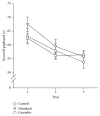History of Illicit Stimulant Use Is Not Associated with Long-Lasting Changes in Learning of Fine Motor Skills in Humans
- PMID: 26819778
- PMCID: PMC4706978
- DOI: 10.1155/2016/9485079
History of Illicit Stimulant Use Is Not Associated with Long-Lasting Changes in Learning of Fine Motor Skills in Humans
Abstract
Little is known about the long-lasting effect of use of illicit stimulant drugs on learning of new motor skills. We hypothesised that abstinent individuals with a history of primarily methamphetamine and ecstasy use would exhibit normal learning of a visuomotor tracking task compared to controls. The study involved three groups: abstinent stimulant users (n = 21; 27 ± 6 yrs) and two gender-matched control groups comprising nondrug users (n = 16; 22 ± 4 yrs) and cannabis users (n = 16; 23 ± 5 yrs). Motor learning was assessed with a three-minute visuomotor tracking task. Subjects were instructed to follow a moving target on a computer screen with movement of the index finger. Metacarpophalangeal joint angle and first dorsal interosseous electromyographic activity were recorded. Pattern matching was assessed by cross-correlation of the joint angle and target traces. Distance from the target (tracking error) was also calculated. Motor learning was evident in the visuomotor task. Pattern matching improved over time (cross-correlation coefficient) and tracking error decreased. However, task performance did not differ between the groups. The results suggest that learning of a new fine visuomotor skill is unchanged in individuals with a history of illicit stimulant use.
Figures





Similar articles
-
Motor cortex and corticospinal excitability in humans with a history of illicit stimulant use.J Appl Physiol (1985). 2012 Nov;113(9):1486-94. doi: 10.1152/japplphysiol.00718.2012. Epub 2012 Sep 6. J Appl Physiol (1985). 2012. PMID: 22961269
-
Hand function is altered in individuals with a history of illicit stimulant use.PLoS One. 2014 Dec 29;9(12):e115771. doi: 10.1371/journal.pone.0115771. eCollection 2014. PLoS One. 2014. PMID: 25545892 Free PMC article.
-
Illicit stimulant use in humans is associated with a long-term increase in tremor.PLoS One. 2012;7(12):e52025. doi: 10.1371/journal.pone.0052025. Epub 2012 Dec 18. PLoS One. 2012. PMID: 23272201 Free PMC article.
-
Prevalence of self-reported movement dysfunction among young adults with a history of ecstasy and methamphetamine use.Drug Alcohol Depend. 2019 Dec 1;205:107595. doi: 10.1016/j.drugalcdep.2019.107595. Epub 2019 Sep 27. Drug Alcohol Depend. 2019. PMID: 31600615
-
MDMA, cortisol, and heightened stress in recreational ecstasy users.Behav Pharmacol. 2014 Sep;25(5-6):458-72. doi: 10.1097/FBP.0000000000000060. Behav Pharmacol. 2014. PMID: 25014666 Review.
Cited by
-
Measuring dexterity in the podiatrist population: a cross-sectional comparison of novice students and experienced podiatrists.BMC Med Educ. 2018 Aug 2;18(1):181. doi: 10.1186/s12909-018-1276-1. BMC Med Educ. 2018. PMID: 30071848 Free PMC article.
References
-
- Ramaekers J. G., Moeller M. R., van Ruitenbeek P., Theunissen E. L., Schneider E., Kauert G. Cognition and motor control as a function of Δ9-THC concentration in serum and oral fluid: limits of impairment. Drug and Alcohol Dependence. 2006;85(2):114–122. doi: 10.1016/j.drugalcdep.2006.03.015. - DOI - PubMed
Publication types
MeSH terms
Substances
LinkOut - more resources
Full Text Sources
Other Literature Sources
Medical

